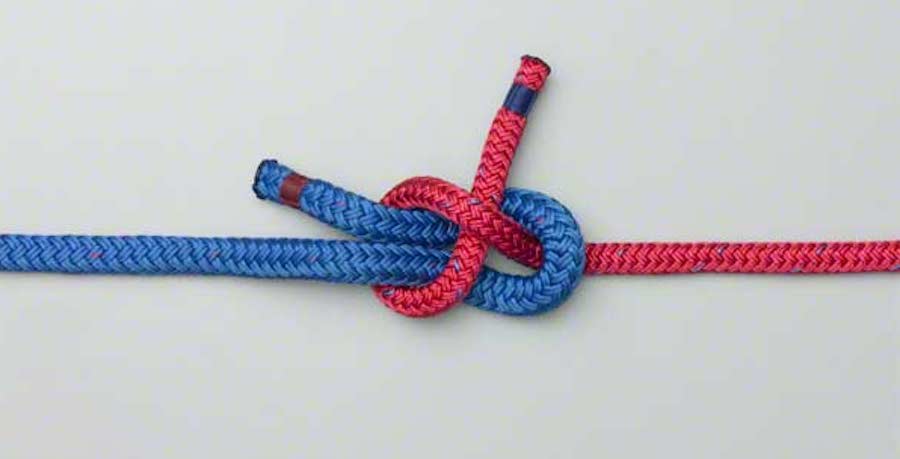Published on the 19th June 2018
Types Of Sailing Knots You Need To Know When On The Sea
Reading Time: 5 min read

Sailing is an ideal pastime; it is a lot of fun, requires skill and dexterity, and can have the added benefit of a brilliant workout.
It is also an activity which prioritises safety, and one of the ways in which to achieve this is to educate yourself in the range of different nautical knots: knowing how to tie a boating knot is crucial.
As you’re preparing your boat for summer, read on for a crash course in the most important types sailing knots!
Here is a list of the 10 most famous types of sailing knots :

Image from pinterest.com
Sheet bend (Or Weavers Knot)
The sheet bend is a know which ties two separate sections of rope together.
It is very useful and very simple to learn :
- Form a loop (or bight) in the thicker rope and hold this in one hand.
- Feed the second rope through this loop, then pass the second rope behind the first.
- Pull this tight, and finally place the end of the smaller rope underneath itself to finish.

Image from animatedknots.com
Bowline Knot
The bowline allows a small loop to be made at the end of a piece of rope, making it useful for securing a mooring line to a rig or post.
It does not slip or bind when a load is placed on it and can be untied quickly and easily.
To create form a loop, leaving enough rope for a loop of the size you desire.
Here is how to do it:
- Pass the end of the rope through this small loop
- Then bring the rope back around and back through the small loop.

Image from campgearcenter.com
Figure 8 Knot (Or Flemish Knot)
Known as a ‘stopper knot’ the figure 8 knot prevents a line sliding out of sight.
It is secure, and not easily undone, as well as being easy to form.
How? Simply:
- Form a loop in the rope
- Bbring the tail behind
- Then pass the tail through this smaller loop to tighten

Image from animatedknots.com
Round Turn And Two Half Hitches
A very useful boating knot, the round turn and two half hitches can be used to secure a mooring post to a dock post or ring.
It is formed by :
- First passing the end of the rope around the post twice
- Pass the end of the rope through the standing end to create the first half hitch
- Pull it tight
- Carry on in the same direction and make the second half hitch, before pulling tight to complete

Image from lrsailingcenter.com
Anchor Hitch (Or Fisherman’s Hitch)
This is an excellent and secure knot, which can, as the name suggests, be used to attach an anchor line to an anchor.
It is very similar to the round turn and two half hitches and can be used in a similar way :
- Pass the tail of the rope twice around the post, making sure the second turn is slack
- Pass the tail over the standing end and under the original slack turn to tie the first half hitch, before continuing around the standing end to tie the second half hitch to finish

Image from katiekat.net
Rolling Hitch
A rolling hitch can be used to attach a smaller rope to a larger one and is useful to have in your inventory of types of sailing knots.
To create a rolling hitch :
- Pass the end around the main rope to make a half hitch
- Carry on, pulling the rope over the first turn, before ticking between the standing end and the first turn
- Tighten to make it secure (this introduces a slight dog-leg in the main rope and continues around to add a final half hitch to finish).

Image from animatedknots.com
Cleat Hitch
Often deceptively simple, the cleat hitch can be used to secure ropes to a cleat.
To form it:
- Pass the rope around the horn from bottom to top, before bringing the rope back down across the middle
- Pass it behind the bottom, and up over the middle in a criss-cross
- Twist a loop into the rope, before hooking it onto the cleat as a half hitch

Image from pinterest.com
Constrictor Knot
The constrictor knot is a clever formation which can be used for a range of purposes.
Whether tying the neck of a sack, preparing to glue ropes together or as a temporary hose clamp, this is a truly versatile knot.
It is also extremely easy to form:
- Simply twist the rope to form a loose figure 8, before folding the loops down around the centre

Image from animatedknots.com
Reef Knot
One of the earliest knots we learn as children, the reef knot is ideal for casting on and off.
It is very simple:
- Take two ropes and cross them to form a half knot
- Cross them a second time and pull the ends tight to form the reef knot

Image from endeavour-sailing.co.uk
Overhand Knot
This is the simplest type of sailing knot and forms the basis for many other, more complex knots.
It is formed by :
- Simply creating a loop
- Passing the end through it

Image from wikihow.com
So if you’re thinking of buying a boat or you are an experienced sailor we hope this article helps you as you as you learn the different types of sailing knots available to you.
Keep up to date with more sailing articles on our blog and check out our boat insurance if you’re looking to get ready for summer.